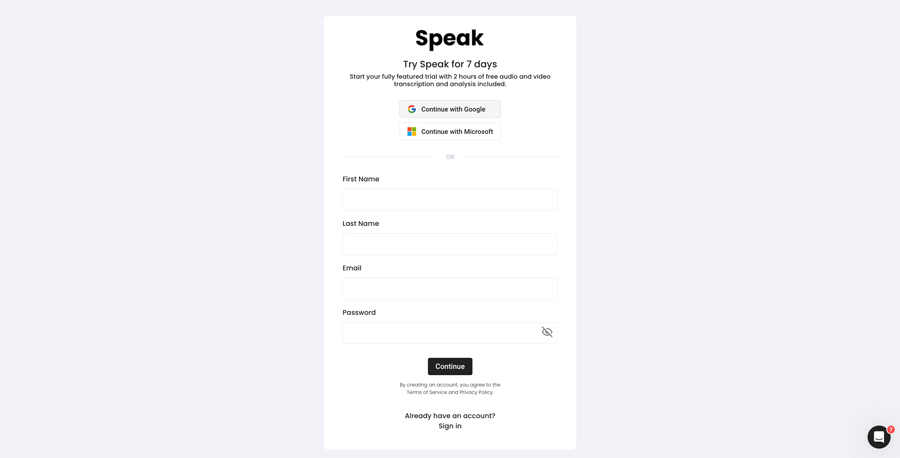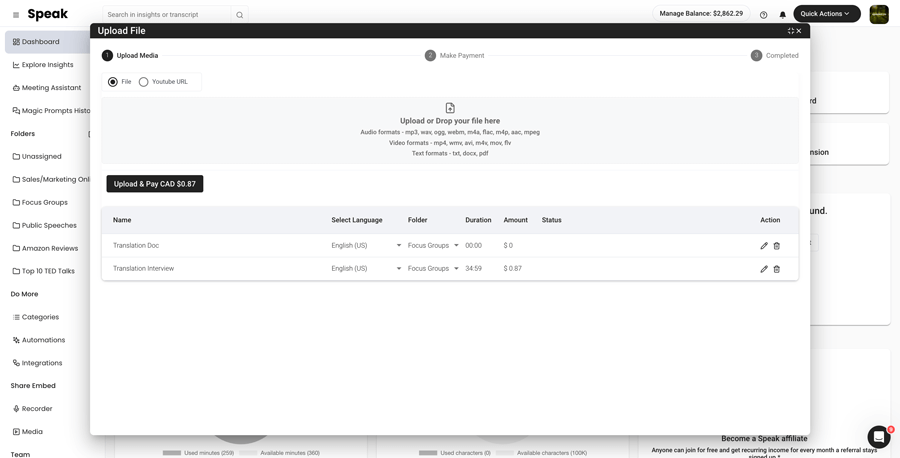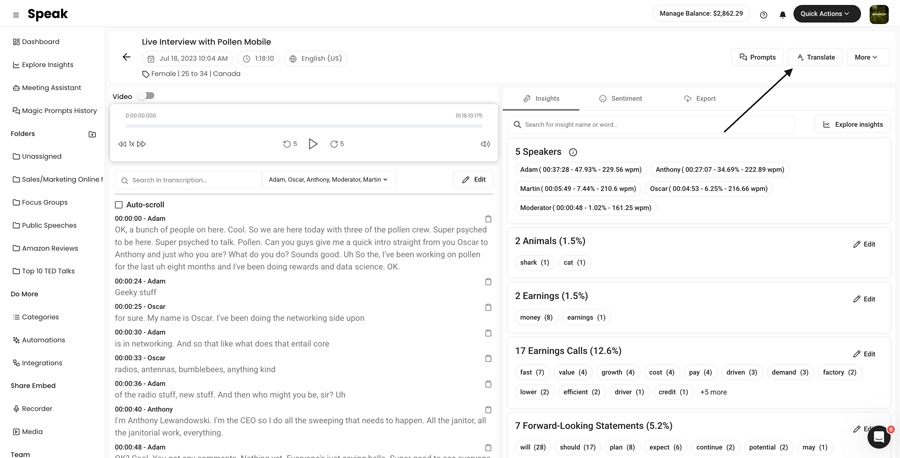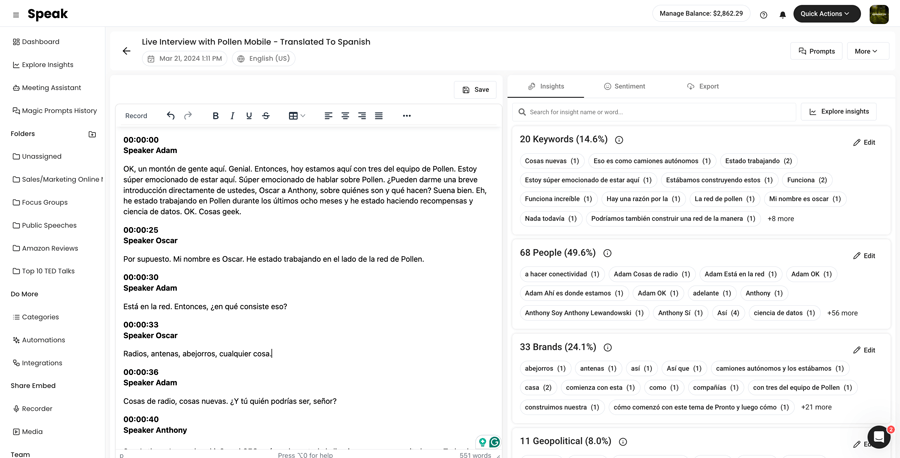How To Translate Chinese (Simplified) to German
Translating Chinese (Simplified) to German is super simple!

Step 1: Register for Speak
Register for Speak using this link.
Once you register, you can instantly begin translating your Chinese (Simplified) to German file(s).

Step 2: Upload Your Chinese (Simplified) file(s)
As soon as you log in, you will be redirected to the dashboard.
Once there, you can select the Quick Action “New Upload”.
In Speak, you can seamlessly upload, transcribe and translate audio, video and text files all at once!

Step 3: Translate Your Chinese (Simplified) file(s) to German
Once the file is uploaded, simply visit your file and select “Translate”.
If it is an audio and video file, Speak will ask you if you want to keep the speaker names and timestamps in the translation.
Want to translate many files at once? No problem!
You can view the files you want to automatically translate from Chinese (Simplified) to German from the folder level and instantly translate as many files as you need with our artificial intelligence translation in just a few clicks.

Step 4: That’s It! View, Analyze, Modify & Export Your New German file(s)
Once the translation is done, you will be alerted and you will see a new document in the same folder your original file is in.
The file will be named the same but with a dash indicating that it is the translated version.
Need support with your Chinese (Simplified) translation?
We are always here and happy to help at Speak!
Just send us a message on live chat on the bottom right corner and we will ensure you are set up for success.
Interested in translating Chinese (Simplified) or other languages to different languages? View our entire list of supported translation languages here.
Automatic, accurate, instant AI translation from Chinese (Simplified) to German is here for you.
Register for Speak using this link and begin translating Chinese (Simplified) to German today.
Unlocking Global Communication: Translate Chinese (Simplified) to German
In today’s interconnected world, the ability to communicate across linguistic barriers is more valuable than ever. This is especially true for businesses and researchers looking to expand their reach into new markets or tap into diverse knowledge bases. Among the myriad of language pairs, translating Chinese (Simplified) to German stands out due to its significant economic and academic potential. Speak AI is at the forefront of leveraging AI translation to bridge this linguistic divide, offering automatic translation solutions that epitomize efficiency, accuracy, and innovation.
The Power of AI Translation: A Gateway to New Opportunities
AI translation, particularly from Chinese (Simplified) to German, is not just about converting text. It’s about opening doors to a world brimming with opportunities. Whether it’s for businesses aiming to penetrate the German market or researchers seeking to collaborate with Chinese scholars, automatic translation serves as a critical tool in global communication.
Benefits Beyond Boundaries
- Instant Access: Say goodbye to language barriers with real-time translation.
- Cost Efficiency: Eliminate the need for costly human translators without compromising on quality.
- Accuracy and Consistency: Leverage sophisticated AI algorithms for translations that maintain the original meaning.
- Integration Ease: Speak AI seamlessly integrates with major platforms like Microsoft Teams, Zoom, Google Meet, and Webex.
Transformative Impact on Research and Business
For researchers, automatic translation accelerates the sharing of scientific discoveries and facilitates international collaborations. Businesses, on the other hand, can localize content quickly and efficiently, enhancing their global presence and customer engagement.
Speak AI: A Pioneer in Simplified Chinese to German Translation
With a user base surpassing 150K and an impressive 4.9 rating on G2, Speak AI stands as a testament to the transformative power of AI in language translation. Our solutions go beyond mere text translation; we offer comprehensive support for audio, video, and real-time meetings, ensuring that your message is heard loud and clear, regardless of the medium.
Comprehensive Coverage
- Automatic Analysis: Dive deep into your translations with AI-powered analysis for insights you can act on.
- AI Meeting Assistant: Effortlessly transcribe and analyze meetings in Chinese (Simplified) and German, streamlining communication.
- Data Visualization: Understand your data better with intuitive visualizations, making insights accessible at a glance.
Use Cases that Matter
Our solutions cater to a wide range of applications, from academic research that transcends language barriers to businesses aiming for global expansion. By enabling seamless Chinese (Simplified) to German translation, we empower you to communicate effectively, irrespective of the linguistic landscape.
Expanding Horizons: Chinese (Simplified) and German in Global Context
The impact of translating Chinese (Simplified) to German goes far beyond individual benefits. It reflects the evolving linguistic dynamics in a globalized economy. Let’s delve into the relevance and richness of these languages within global contexts.
Global Footprints of Chinese and German
Chinese (Simplified) and German are not just languages; they are powerful conduits of culture, commerce, and collaboration. They represent the linguistic heritage of two of the world’s largest economies, with China leading as the second-largest economy and Germany dominating as Europe’s economic powerhouse.
Chinese (Simplified): A Bridge to Asia
Chinese is the most spoken language worldwide, with over a billion native speakers, primarily in China, Singapore, and Malaysia. Its simplified form, introduced to increase literacy, has become the standard for business, education, and international communication within Chinese-speaking communities.
German: Europe’s Linguistic Linchpin
German, with its strong foothold in Europe, is spoken by over 100 million people. It’s not only the official language of Germany but also Austria, Switzerland, Luxembourg, and Liechtenstein. German’s economic influence extends across the European Union and into the realms of science, literature, and philosophy.
Fascinating Insights: Chinese (Simplified) and German
Understanding the nuances of these languages uncovers intriguing aspects of culture and history, while highlighting the utility of translating between these linguistic giants.
Fun Facts and Figures
- Chinese characters, despite being logographic, encompass a vast array of meanings, making the language rich in poetry and literary expression.
- German is known for its compound words, creating extensive terms like “Rechtsschutzversicherungsgesellschaften” (insurance companies providing legal protection), showcasing the language’s precision.
Diverse Yet Unified
While Chinese (Simplified) and German originate from entirely different language families—Sino-Tibetan and Indo-European, respectively—they share common ground in their influence on global commerce, technology, and culture. This commonality underscores the importance of building bridges through translation, fostering mutual understanding and cooperation across continents.
Conclusion: The Future is Translingual
Speak AI’s advancements in automatic translation are not just responding to the current demands of global communication; they are shaping the future. By facilitating seamless translation from Chinese (Simplified) to German, we are not only breaking down language barriers but also uniting diverse communities through the power of understanding. The journey towards a translingual world is complex, but with AI’s help, it’s within our grasp. Embrace the change, and let Speak AI guide you through the new linguistic landscapes unfolding before us.
—
FAQ Section
What locations are Chinese (Simplified) and German popular?
Chinese (Simplified) is predominantly used in China, Singapore, and Malaysia, serving as a crucial lingua franca in these regions. On the other hand, German enjoys popularity not just in Germany but also in Austria, Switzerland, Luxembourg, and Liechtenstein, making significant cultural and economic contributions across Europe.
What are some fun facts about Chinese (Simplified) and German?
- Chinese is the only modern pictographic language, with thousands of characters each representing a concept or object.
- German’s penchant for compound words allows it to describe very specific concepts or objects succinctly, albeit with some rather long words.
What are the differences and similarities between Chinese (Simplified) and German?
While Chinese (Simplified) is characterized by its use of logograms, German employs a Latin-based alphabet system. Despite these fundamental differences, both languages serve as key players in international business and cultural exchange, highlighting the value of translation initiatives to bridge the gap between these linguistic worlds.
Translate Chinese (Simplified) To These Other Supported Languages:
- Translate Chinese (Simplified)-to-Albanian
- Translate Chinese (Simplified)-to-Amharic
- Translate Chinese (Simplified)-to-Arabic (Egypt)
- Translate Chinese (Simplified)-to-Arabic (Iraq)
- Translate Chinese (Simplified)-to-Arabic (Israel)
- Translate Chinese (Simplified)-to-Arabic (Jordan)
- Translate Chinese (Simplified)-to-Arabic (Kuwait)
- Translate Chinese (Simplified)-to-Arabic (Lebanon)
- Translate Chinese (Simplified)-to-Arabic (Oman)
- Translate Chinese (Simplified)-to-Arabic (Palestinian Authority)
- Translate Chinese (Simplified)-to-Arabic (Qatar)
- Translate Chinese (Simplified)-to-Arabic (Saudi Arabia)
- Translate Chinese (Simplified)-to-Arabic (Syrian Arab Republic)
- Translate Chinese (Simplified)-to-Arabic (United Arab Emirates)
- Translate Chinese (Simplified)-to-Arabic Modern Standard (Bahrain)
- Translate Chinese (Simplified)-to-Armenian
- Translate Chinese (Simplified)-to-Azerbaijani
- Translate Chinese (Simplified)-to-Bengali
- Translate Chinese (Simplified)-to-Bosnian
- Translate Chinese (Simplified)-to-Bulgarian
- Translate Chinese (Simplified)-to-Catalan
- Translate Chinese (Simplified)-to-Chinese (Cantonese, Traditional)
- Translate Chinese (Simplified)-to-Chinese (Simplified)
- Translate Chinese (Simplified)-to-Chinese (Traditional)
- Translate Chinese (Simplified)-to-Croatian
- Translate Chinese (Simplified)-to-Czech
- Translate Chinese (Simplified)-to-Danish
- Translate Chinese (Simplified)-to-Dari
- Translate Chinese (Simplified)-to-Dutch
- Translate Chinese (Simplified)-to-English
- Translate Chinese (Simplified)-to-English (Australia)
- Translate Chinese (Simplified)-to-English (India)
- Translate Chinese (Simplified)-to-English (Ireland)
- Translate Chinese (Simplified)-to-English (New Zealand)
- Translate Chinese (Simplified)-to-English (Scottish)
- Translate Chinese (Simplified)-to-English (South African)
- Translate Chinese (Simplified)-to-English (United Kingdom)
- Translate Chinese (Simplified)-to-English (United States)
- Translate Chinese (Simplified)-to-Estonian
- Translate Chinese (Simplified)-to-Farsi (Persian)
- Translate Chinese (Simplified)-to-Finnish
- Translate Chinese (Simplified)-to-French
- Translate Chinese (Simplified)-to-French (Canada)
- Translate Chinese (Simplified)-to-Georgian
- Translate Chinese (Simplified)-to-German
- Translate Chinese (Simplified)-to-German (Swiss)
- Translate Chinese (Simplified)-to-Greek
- Translate Chinese (Simplified)-to-Gujarati
- Translate Chinese (Simplified)-to-Haitian Creole
- Translate Chinese (Simplified)-to-Hausa
- Translate Chinese (Simplified)-to-Hebrew
- Translate Chinese (Simplified)-to-Hindi
- Translate Chinese (Simplified)-to-Hungarian
- Translate Chinese (Simplified)-to-Icelandic
- Translate Chinese (Simplified)-to-Indonesian
- Translate Chinese (Simplified)-to-Irish
- Translate Chinese (Simplified)-to-Italian
- Translate Chinese (Simplified)-to-Japanese
- Translate Chinese (Simplified)-to-Kannada
- Translate Chinese (Simplified)-to-Kazakh
- Translate Chinese (Simplified)-to-Korean
- Translate Chinese (Simplified)-to-Latvian
- Translate Chinese (Simplified)-to-Lithuanian
- Translate Chinese (Simplified)-to-Macedonian
- Translate Chinese (Simplified)-to-Malay
- Translate Chinese (Simplified)-to-Malayalam
- Translate Chinese (Simplified)-to-Maltese
- Translate Chinese (Simplified)-to-Marathi
- Translate Chinese (Simplified)-to-Mongolian
- Translate Chinese (Simplified)-to-Norwegian
- Translate Chinese (Simplified)-to-Pashto
- Translate Chinese (Simplified)-to-Persian
- Translate Chinese (Simplified)-to-Polish
- Translate Chinese (Simplified)-to-Portuguese
- Translate Chinese (Simplified)-to-Portuguese (Brazilian)
- Translate Chinese (Simplified)-to-Portuguese (Portugal)
- Translate Chinese (Simplified)-to-Punjabi
- Translate Chinese (Simplified)-to-Romanian
- Translate Chinese (Simplified)-to-Russian
- Translate Chinese (Simplified)-to-Serbian
- Translate Chinese (Simplified)-to-Sinhala
- Translate Chinese (Simplified)-to-Slovak
- Translate Chinese (Simplified)-to-Slovenian
- Translate Chinese (Simplified)-to-Somali
- Translate Chinese (Simplified)-to-Spanish
- Translate Chinese (Simplified)-to-Spanish (Mexico)
- Translate Chinese (Simplified)-to-Swahili
- Translate Chinese (Simplified)-to-Swedish
- Translate Chinese (Simplified)-to-Tamil
- Translate Chinese (Simplified)-to-Telugu
- Translate Chinese (Simplified)-to-Thai
- Translate Chinese (Simplified)-to-Turkish
- Translate Chinese (Simplified)-to-Ukrainian
- Translate Chinese (Simplified)-to-Urdu
- Translate Chinese (Simplified)-to-Uzbek
- Translate Chinese (Simplified)-to-Vietnamese
- Translate Chinese (Simplified)-to-Welsh



